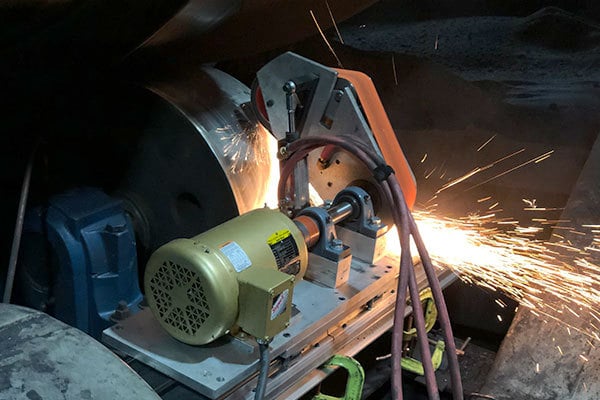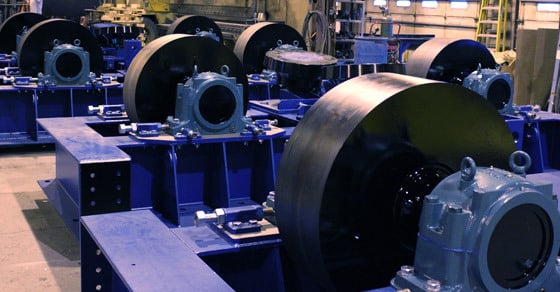A properly aligned and maintained trunnion wheel, or trunnion roller, can last the life of a rotary drum, providing smooth rotation and mechanical stability for decades. But when rotary drums are not properly maintained, or when trunnion wheels experience damage or wear due to external factors, it becomes necessary to replace them.
As the industry’s most reputable rotary drum service provider, we’re laying out everything you need to know about the trunnion replacement process, including whether to repair or replace, what the replacement process looks like, and how to get started.
Worn Trunnion Wheels: Repair or Replace?
Not all wear conditions require replacement; when trunnions experience minimal-to-moderate wear patterns such as pitting, timing marks, spalling, and the like, they can often be refurbished through grinding.
Trunnion grinding is a resurfacing technique in which the outermost surface of the trunnion is ground away to remove the worn portion of the surface. Depending on the severity of the wear, this technique can be employed multiple times throughout a trunnion’s life.

Trunnion wheel (roller) grinding in progress
Trunnion grinding is significantly more cost-effective than replacement, and as such, FEECO recommends this over replacement where possible.
When damage is severe, however, or the trunnion has reached a 5% or greater loss of its original diameter, replacement becomes essential, as beyond this, the slope of the drum is affected, throwing off alignment and potentially even the processing conditions.
Determining Whether or Not to Relace a Trunnion Wheel
Using the 5% rule of thumb as a guide, plant managers can usually assess the need for replacement on their own. If the trunnion wheel’s original diameter was 40”, a 5% loss would be 2”, so in measuring the trunnion’s current diameter, anything approaching or less than 38” should be replaced. If the trunnion has not experienced a significant loss in diameter, grinding is typically an option.
One important consideration to keep in mind in assessing the potential replacement of a trunnion wheel is the surface hardness.
Trunnion Wheel Surface Hardness
The majority of trunnion wheels are heat treated and oil quenched to achieve a certain level of surface hardness on the metal. Depending on the level of surface hardness, wear could be exposing softer metal beneath the surface. When softer metal is exposed, trunnion wear is accelerated.
While most trunnion wheels are heat hardened, not all are, and the extent to which they are can vary. Some smaller drums may not require trunnions to be heat hardened at all, while other drums may have been improperly spec’d with non-heat-hardened trunnions.
When the level (or lack) of surface hardening is insufficient, trunnions should be replaced to avoid accelerated wear and potentially more severe issues.
Trunnions can also increase in surface hardness over time as a result of “work hardening;” as the trunnion continues to flex under contact with the tire during rotation, the grain structure on the surface of the metal changes and becomes more brittle. This can actually help to discourage wear.
Similarly, tires (riding rings) can also experience work hardening. The selection of a new trunnion wheel must take tire hardness into consideration as well; since trunnion wheels rotate roughly eight times for every one rotation of the tire, they experience a faster wear rate. For this reason, trunnions are made of a harder material than tires, so they do not wear out at a faster rate. Proper selection of trunnion hardness is critical to acquiring a trunnion that will stand the test of time.
FEECO Customer Service Engineers come equipped to measure the hardness of both tires and trunnions during inspections.
A Note on Alignment
When a drum falls out of alignment, either naturally, or as a result of an underlying issue, trunnion wear is always accelerated, no matter the hardness of the material. Rotary drum misalignment puts added stress on all components, but is especially tough on tires and trunnions. Therefore, rotary drums should routinely be realigned to minimize wear and potential damage. Drums that have been allowed to operate in a misaligned condition for an extended period of time may require trunnion replacement.

Replacement trunnion wheels
The Trunnion Wheel Replacement Process
The trunnion wheel replacement process can vary depending on the allowable downtime, the level of wear on other trunnions, and other site factors.
It is ideal to replace all four trunnion wheels at the same time, as this will ensure base conditions are consistent and are likely to wear consistently in the future. When only one trunnion is replaced, the alignment can be significantly affected, depending on the level of wear of the other trunnion wheels.
Additionally, encouraging consistent wear helps to prevent unnecessary downtime in the future for changing out the remaining trunnion wheels on an as-needed basis.
How Plant Managers Can Prepare for Trunnion Wheel Replacement
The trunnion wheel replacement process requires the rotary drum to be lifted off of its base. Plant managers will have to ensure the drum is safely lifted out of place and cribbed for proper support, should the lifting device fail. Of course, it goes without saying that the drum must also be locked out and tagged out.
Once the drum has been lifted out of place, operators or maintenance personnel should make scribe marks to indicate placement of the existing trunnion. Trunnion wheel assembly surfaces should also be cleaned.
Replacing the Trunnion Wheel
The actual replacement process will need to be done by the OEM or other qualified service engineer.
Once the drum has been lifted and is securely supported, the service engineer will make additional scribe marks to indicate new trunnion placement most optimally positioned for alignment.
If all trunnions are to be replaced at the same time, these marks are not necessary, as alignment will essentially be started from scratch. The service engineer will remove the old trunnion(s) and clean out the base. At this time, the service engineer will also check for any cracks or abnormalities in the base that should be repaired prior to new trunnion placement.
Once the trunnion base has been cleaned and inspected, the new trunnion can be put into position using the scribe marks. The service engineer will make adjustments to the trunnion assembly to fine-tune its positioning for proper alignment.
At this point, the drum can be lowered back onto its base and started up. The service engineer will confirm that the base is positioned as desired. From start to finish, including prep work, lockout tagout, and cleaning, this process typically takes between 4-8 hours for a single averagely sized trunnion.
If only one trunnion has been replaced, the drum should be realigned at this point to account for any differences associated with the new trunnion diameter. If all four trunnions were replaced, a realignment is not necessarily required, but recommended.
In the event that an alignment is not feasible due to time constraints, the service engineer will likely need to shim the trunnion or make other adjustments to account for the change in diameter.
Will the tire also require replacement?
Many plant managers wonder if they must also replace tires when they replace trunnions.
Tires do not require replacement as frequently as trunnions – only once they have reached a 10% reduction in original diameter, or when severe damage, such as a major crack, occurs. If the tires are also experiencing wear, they can typically be refinished via grinding.
How to Get Started With Trunnion Wheel Replacement
Those ready to replace their trunnion wheel(s) can fill out the FEECO contact form to request a quote. If the original trunnion wheel was manufactured by FEECO, only the serial number and any changes in specification are needed. If not manufactured by FEECO, data such as face width, material of construction, shaft length, and more, will be necessary.
Those unsure of whether or not their trunnion wheel(s) requires replacement can submit an inquiry to the FEECO Customer Service Team to discuss whether or not grinding may be an option.
Conclusion
Trunnion wheels are a critical component in rotary drum operation and mechanical stability. It is important to maintain trunnions properly to maximize their life span, resurfacing and replacing them as needed to avoid more widespread effects to the drum.
The FEECO Customer Service Team provides timely parts and service support for all rotary drums, whether they were manufactured by FEECO or a competitor. Whether you need grinding, alignment, trunnion replacement, or otherwise, the FEECO Customer Service Team has the equipment and expertise to get the job done quickly and accurately. For more information, contact us today!

